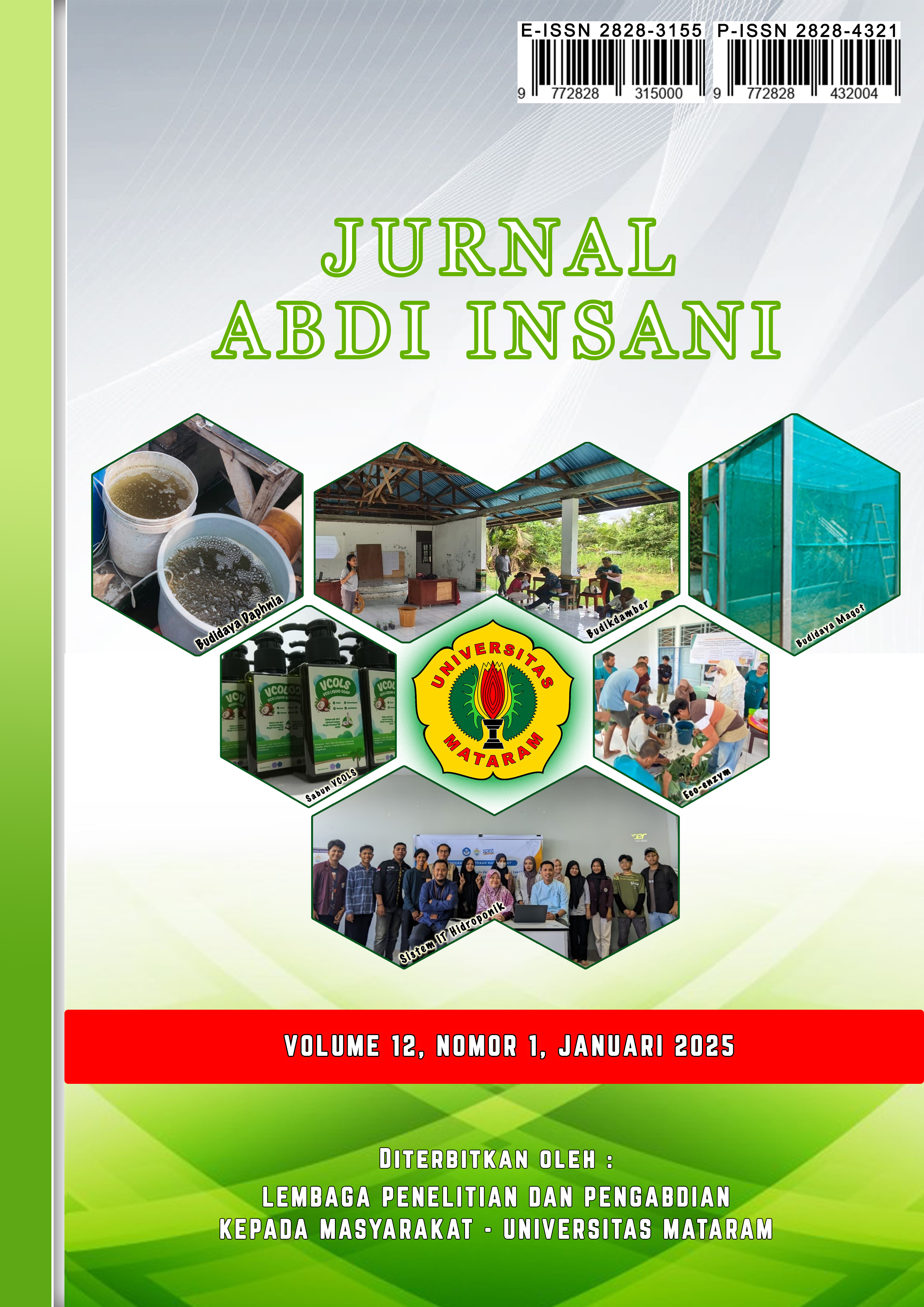PENGENALAN PRODUK BERBASIS ISOLAT PROTEIN IKAN PADA MASYARAKAT PUTAT JAYA BARAT-SURABAYA SEBAGAI UPAYA DIVERSIFIKASI PRODUK UNTUK MENCEGAH STUNTING
DOI:
https://doi.org/10.29303/abdiinsani.v12i1.2174Keywords:
Stunting, Diversification, Fisheries, Protein IsolateAbstract
The phenomenon of stunting has caught global attention as it may disrupt children growth and development which is important for national sakes. This problem also occurred on the community of Putat Jaya Barat, Surabaya. Despite the decrease of stunting prevalence on 2022 by 21.6%, the community of Surabaya should maintain their awareness to prevent the occurrence of stunting near in the future. Therefore, in order to prevent the occurrence of stunting, it is necessary to provide community service which is related to the introductory of protein isolate-based products from fisheries commodities. Protein isolate as a functional food has concentrated protein content which may fulfil daily consumption need. This community service activity was conducted to provide participants with the knowledge of stunting phenomenon, fisheries product diversification, and the demonstration on isolate protein production method. The result of this this community service activity showed that the participants were poorly informed with the stunting information, however the participants were still able to provide their family with adequate food consumption based on the concept of “4 Sehat 5 Sempurna”. The participants were also provided with the understanding toward fisheries product diversification. The questionnaires evaluation showed that the participants need further assistance related to the application of protein isolate on fisheries products, with the nutritional information, and healthy life socialization.
Downloads
References
Adzura, M., & Fathmawati, Y. (2021). Hubungan Sanitasi, Air Bersih dan Mencuci Tangan dengan Kejadian Stunting Pada Balita di Indonesia. Jurnal Sulolipu : Media Komunikasi Sivitas Akademika DanMasyarakat, 26(2), 173-180.
Andhikawati, A., Junianto, Permana, R., & Oktavia, Y. (2021). Review: Komposisi Gizi Ikan Terhadap Kesehatan Manusia. Marinade, 4(2), 76-84. http://doi.org/10.31629/marinade.v4i02.3871
Anjani, D. M., Nurhayati, S., & Immawati. (2024). Penerapan Pendidikan Kesehatan Terhadap Pengetahuan Ibu Tentang Stunting Pada Balita di Wilayah Kerja UPTD Puskesmas Rawat Inap Banjarsari Metro Utara. Jurnal Cendekia Muda, 4(1), 62-69.
BKPK. 2023. Angka Stunting Tahun 2022 Turun Menjadi 21,6 Persen. Retrieved from https://www.badankebijakan.kemkes.go.id/angka-stunting-tahun-2022-turun-menjadi-216-persen/
BPS. 2023. Nilai Prevalensi Stunting Kota Surabaya Survei Status Gizi Indonesia. Retrieved from https://sehatnegeriku.kemkes.go.id/baca/rilis-media/20230125/3142280/prevalensi-stunting-di-indonesia-turun-ke-216-dari-244/
Damongilala, L. J., & Harikedua, S. D. (2020). Diversifikasi Produk Perikanan: Fish Burger. Techno Science Journal, 2(2), 61-68.
Elavarasan K. (2018). Importance of Fish in Human Nutrition. Training Manual On Seafood Value Addition. ICAR Central Institute of Fisheries Technology, 1(1), 1-6.
Fitriagustiani., Pasmawati., Khairillah, Y. N., Pratama, S. F., & Alang, H. (2023). Diversifikasi Produk Nutrisi Berbahan Dasar Ikan Lele Pada Kelompok NelayanWanita Kab. Mempawah sebagai Salah Satu Upaya Penanganan Stunting. Poltekita: Jurnal Pengabdian Masyarakat, 4(4), 1009-1017.
Gibson, E., Stacey, N., Sunderland, T. C. H., & Adhuri, D. S. (2020). Dietary diversity and fish consumption of mothers and their children in fisher households in Komodo District, Eastern Indonesia. PLOS ONE, 15(4), 1–22.
Hafiludin. (2015). Analisis Kandungan Gizi pada Ikan Bandeng yang Berasal Dari Habitat yang Berbeda. Jurnal Kelautan, 8(1), 37-43. https://doi.org/10.21107/jk.v8i1.811
Haryati, S., Sukarno., Budijanto, S., & Prangdimurti, E. (2020). Characterization of functional properties catfish protein isolates (Clarias sp.). IOP Conf. Series: Earth and Environmental Science, 404, 012031.
Khairani. (2020). Situasi Stunting di Indonesia. Jendela Data Dan Informasi Kesehatan, 208(5), 1–34.
Lu, Z., Chen, T. C., Zhang, A., Persons, K. S., Kohn, N., Berkowitz, R., Martinello, S., & Holick, M. F. (2007). An Evaluation of the Vitamin D3 Content in Fish: Is the Vitamin D Content Adequate to Satisfy the Dietary Requirement for Vitamin D?. J Steroid Biochem Mol Bio, 103(3-5), 642-645.
Permenkes. 2019. Peraturan Menteri Kesehatan Nomor 4 Tahun 2019 tentang Standar Teknis Pemenuhan Mutu Pelayanan Dasar Pada Standar Pelayanan Minimal Bidang Kesehatan. Jakarta.
Rahman, H., Rahmah, M., & Saribulan, N. (2023). Upaya Penanganan Stunting di Indonesia: Analisis Bibliometrik dan Analisis Konten. Jurnal Ilmu Pemerintahan Suara Khatulistiwa, 8(1), 44-59.
Ramlah., Soekendaesi, E., Hasyim, Z., & Hasan, M. S. (2016). Perbandingan Kandungan Gizi Ikan Nila Oreochromis niloticus Asal Danau Mawang Kabupaten Gowa dan Danau Universitas Hasanuddin Kota Makassar. Jurnal Biologi Makassar (BIOMA), 1(1), 39-46. https://doi.org/10.20956/bioma.v1i1.1098
Saputri, R. A. (2019). Upaya Pemerintah Daerah Dalam Penanggulangan Stunting Di Provinsi Kepulauan Bangka Belitung. Jurnal Dinamika Pemerintahan, 2(2), 152–168.
Silvia, V., & Fajar, M. (2023). Sosialisasi Pentingnya Mengonsumsi Makanan 4 Sehat 5 Sempurna Kepada Anak Sekolah Dasar. Si Kemas Journal, 1(4), 163-168.
Sitanggang, S., Hasibuan B., Pane, C. E., Girsang, D. S. L., Saragih, I. J., & Sari, N. (2021). Evaluasi Nilai Gizi Mineral (Fe, Zn Dan Ca) Pada Pangan DenganPenambahan Tepung Ikan Melalui Analisis Bioavaibilitas : Literature Review. Jurnal Andaliman: Jurnal Gizi Pangan, Klinik, dan Masyarakat, 1(2), 22-30.
Sunardi, S. S., Johan, V. S., & Zalfiatri, Y. S., (2018). Pemanfaatan Rebung Betung dalam Pembuatan Bakso Ikan Toman. Jurnal Teknologi dan Industri Pertanian Indonesia, 10(2), 6-13. https://doi.org/10.17969/jtipi.v10i2.11100
Sundari, D., Almasyhuri., & Lamid, A. (2015). Pengaruh Proses Pemasakan Terhadap Komposisi Zat Gizi Bahan Pangan Sumber Protein. Media Litbangkes, 25(4), 235-242.
Temple, R. J. (2022). A rational definition for functional foods: A perspective. Frontiers in Nutrition, 9. 957516. https://doi.org/10.3389/fnut.2022.957516
WHO. 2021. The UNICEF/WHO/WB Joint Child Malnutrition Estimates (JME) group released new data for 2021. Retrieved from https://www.who.int/news/item/06-05-2021-the-unicef-who-wb-joint-child-malnutrition-estimates-group-released-new-data-for-2021
WHO. 2014. Who Global Database on Child Growth and Malnutrition. Retrieved from https://platform.who.int/nutrition/malnutrition-database




















